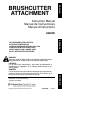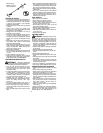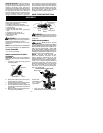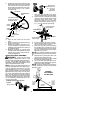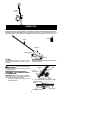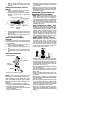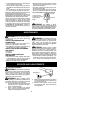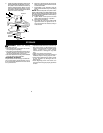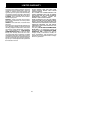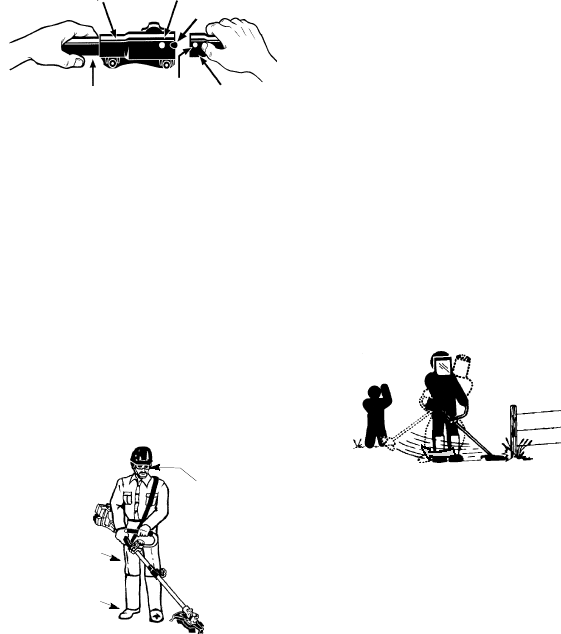
7
3. While securely holding the upper shaft,
pull the attachment straight out of the
coupler.
INSTALLING OPTIONAL ATTACH-
MENTS
1. Remove the shaft cap from the attach-
ment (if present) and discard.
2. Position locking/release buttonof attach-
ment into guide recess of upper shaft
coupler.
Coupler
Primary Hole
Upper
Shaft
Locking/
Release
Button
Attachment
Guide Recess
3. Pushtheattachmentintothecoupleruntil
the locking/release button snaps into the
primary hole.
4. Beforeusingthe unit,tightentheknobse-
curely by turning clockwise.
INSTALLING ATTACHMENT
HANGER
An attachment hangeris provided forstorage
whenattachmentis notin use.To install hang-
er on attachment:
1. Remove the shaft cap from the attach-
ment (if present) and discard.
2. Press and hold the locking/release but-
ton.
3. Push hanger onto the attachment until
the locking/release button snaps into the
hole.
OPERATING POSITION
Boots
Heavy ,
Long Pants
Eye Protection
ALWA YS WEAR:
Cut from your left to your right.
NOTE:
This brushcutter attachment is not
designed for use with electric powerheads.
When operating unit with brushcutter attach-
ment, clip shoulder strap onto up per shoulder
strap clamp, stan d as shown and check for the
f ollo wing :
S
Wear eye protection and heavy clothing.
S
Keeparms extendedwithrighthandholding
the trigger handle of powerhead.
S
Keep left arm extended with left hand hold-
ing the handlebar.
S
Keep unit below waist level.
S
Shoulder strap pad should be centered on
your left shoulderand dangersign centered
on your back.
S
Maintain full weight of tool on left shoulder.
S
Without bending over , ke ep the blade near
and parallel to the ground andnot crowdedin-
to material being cut.
OPERATING INSTRUCTIONSFOR
BRUSHCUTTER ATTACHMENT
S
Blade Thrust
is a reaction t hat only oc curs
when u sing a bladed unit. This reaction can
cause se rious injury such as amputation.
Carefully study this section. It is importantthat
you understand what causes bla de thrust,
how you can reduce the chance of its occur-
ring, and how you canre main in control of u nit
if blade thrust occurs.
S
WHAT CAUS ES BLADE THRUS T
--
Blad e
Thrust
can occur when spinn ing blade con-
tacts a nobjectthatitdoes n otcut. This contact
causes blade to stop for an instant and then
suddenly move or “th rust” away from object
that was hit. The “thrusting” r eaction can be
violent enough to ca use operator to b e pro-
pelled in any direction and lose control of unit.
Theuncontrolled unit cancause serious injury
if blade contacts operator or others.
S
WHEN BLADE THRUST OCCURS --
Blade Thrust
can occur without warning if
the blade snags, stalls, or binds. This is
more likely to occur in areaswhereit is diffi-
cult to see the material being cut. By using
the unit properly, the occurrence of blade
thrust will be reduced and the operator will
be less likely to lose control.
S
Cutonlygrass, weeds, an d wood y bru sh upto
1/2 inch (1 cm) in diameter with weed blade.
Do not let blade contact material it cannot cut
su chas stum ps, r ocks , fence s , m et al, et c ., o r
clusters of hard, woody brush with a diameter
greater than 1/2 inch (1 cm).
S
Useasharpblade.Adullbladeis morelikely
to snag and thrust.
S
Cut on ly at full throttle. The b lade will have
maximum cu tting power and is less like ly to
bind or stall.
S
“Feed” the blade deliberately and not too
rapidly.The bladecan thrustaway if it is fed
too rapidly.
S
Cut only from your left to your right. Cutting on
right side of the shield will th row debr is a wa y
from the operator .
S
Use the shoulder strap and keepa firm grip
on the unit with both hands. A properly ad-
justedshoulderstrap willsupport theweight
of the unit, freeing your arms and hands to
control and guide the cutting motion.
S
Keep feet comfortably spread a part and
braced for a possible sudden, rapid th rust of
unit. Do not overrea ch. Keep firm foo ting and
balance.



